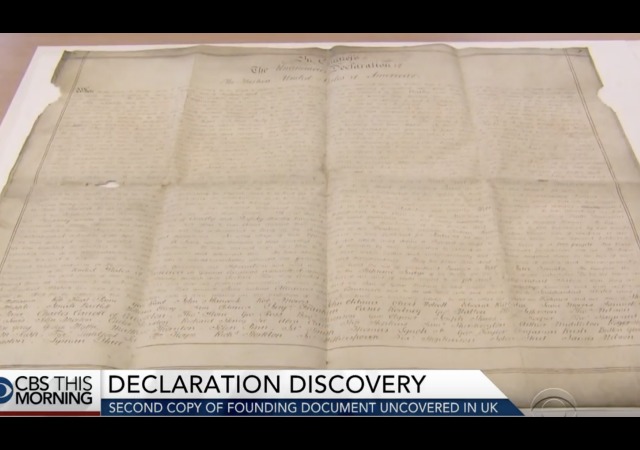Rare Copy of Declaration of Independence Discovered in England
“That these united Colonies are, and of Right ought to be Free and Independent States…”

Can you imaging finding something like this? One of the greatest pieces of writings in history has a second copy…in England. Harvard University researcher Emily Sneff came across it back in 2015 when she searched for the Declaration of Independence in Britain. She found something in a West Sussex record office when an item struck her “as odd because it mentioned parchment, a material suggesting a document made for a special occasion and not simply a broadside copy.” From The Guardian:
“I reached out to them a bit skeptically,” Sneff said. “The description was a little vague but once we saw an image and talked to a conservator we started to get excited.”
Before Sneff asked, the British officials had never taken a close look at the manuscript. They had received it in 1956 from a local man, who worked with a law firm that represented the dukes of Richmond. “The closer we looked at it there were just things that made it a clearly unique and mysterious document,” Sneff said.
[Harvard Professor Danielle] Allen and Sneff first tried to deduce when and where the manuscript was made by analyzing handwriting, spelling errors and parchment styles and preparation. They concluded it dated to the 1780s, and was produced in America, most likely in New York or Philadelphia.
Their next question proved more difficult: who was the man behind the parchment? Allen and Sneff believe the leading candidate was James Wilson, a Pennsylvania delegate to the continental congress, one of six men to sign both the declaration and constitution, and, later, one of the original supreme court justices. The researchers argue that Wilson, who argued vociferously for a popularly-elected president and separation of powers, played a more influential role in American history than most historians have recognized.
The clue that led them to Wilson, Sneff said, was a stark anomaly on the manuscript compared to its counterpart in Washington DC and later copies: “The names of the signers are all scrambled.”
Allen and Sneff presented the document, “known as ‘The Sussex Declaration,'” last week at Yale.
Now the two experts will try to find out how it landed in Chichester:
Copies of the declaration made their way to England in the wake of its original 1776 signing, but the Sussex Declaration was made sometime in the next decade, years when America’s leading statesmen were at odds over a post-war financial crisis, an armed uprising and an uncertain constitution. Somehow the manuscript landed in Britain, possibly in the possession of the dukes of Richmond.
Sneff said she is hoping to gain access to the papers of the dukes to trace the declaration’s history, possibly as far back as Charles Lennox, a contemporary of George III who was called “the radical duke” because he supported American colonists in their rebellion against the king and parliament.
“It would be nice to associate this document with the radical duke,” Sneff said.
 DONATE
DONATE
Donations tax deductible
to the full extent allowed by law.









Comments
This is sort of wild that it took this long to surface. Until it is authenticated though, we are not sure exactly if it is what it is claimed to be.
“The names of the signers are all scrambled.”
Huh?
The Guardian is legendary for its typos, but is usually not meaningless.
They’re listed in no particular order.
From the Grauniad:
Unlike previously known copies of the declaration, which have signatures grouped by states, the Sussex copy has its signatures in a patterned jumble. Sneff and Allen hypothesize that the appearance of randomness was deliberate and symbolic, part of a nationalist argument that the United States was founded by citizens, each created equal, and not by a looser confederation of states.
Wilson drew the researchers’ attention, Sneff said, because he repeatedly “invoked the declaration but with the understanding that the declaration was signed by one community, one group of individuals, that they were not enumerated by states.”
You figure at least one copy had to go back to each of the colonies turned states, a few would have been required for reference in New York and Philadelphia and at least a copy would have had to have been sent to the King himself to prove legitimacy. There should be at least dozens of hand made copies.